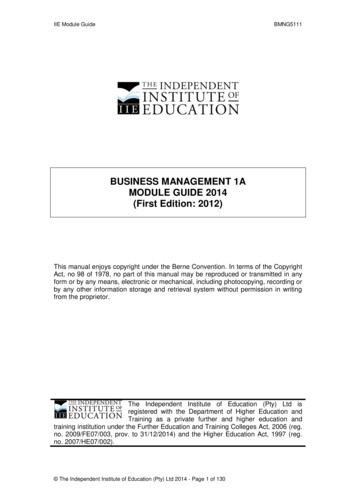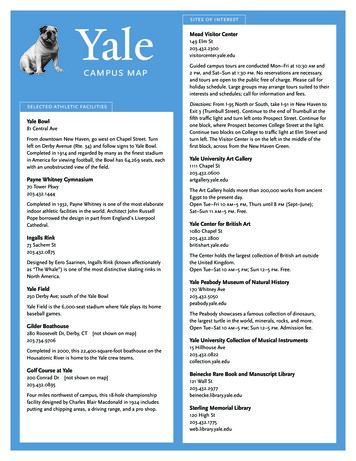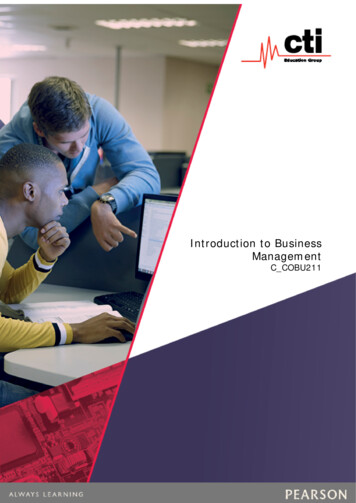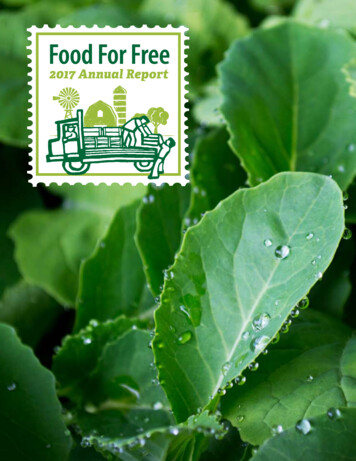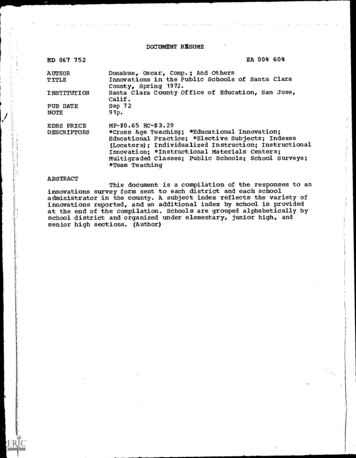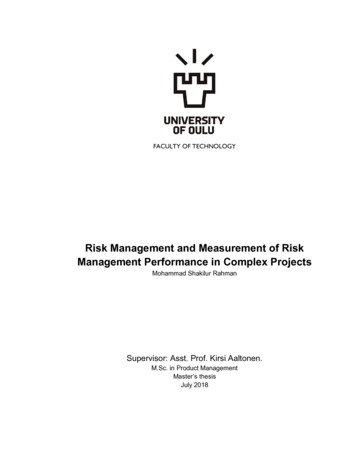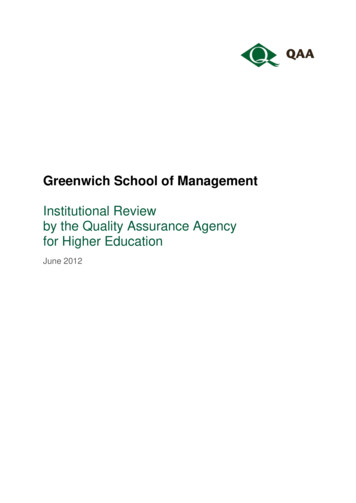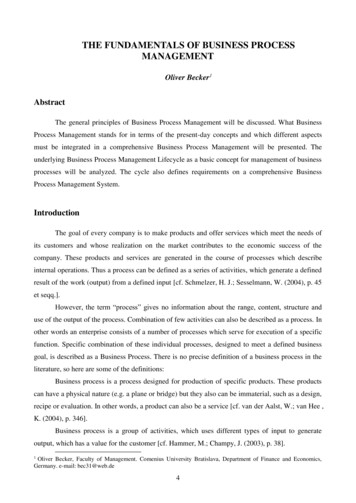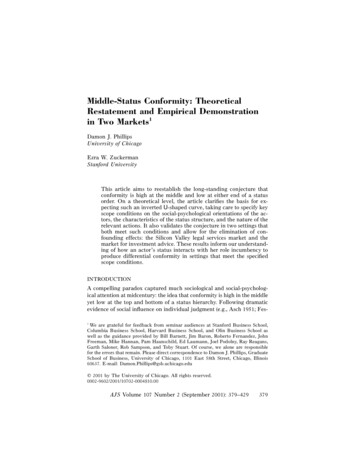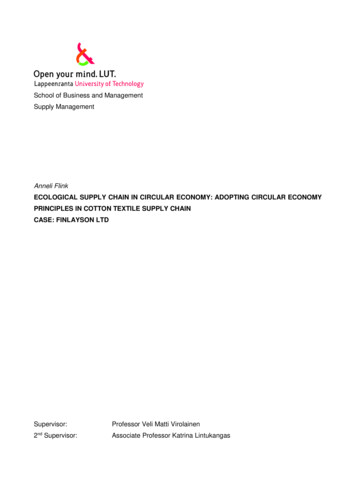
Transcription
School of Business and ManagementSupply ManagementAnneli FlinkECOLOGICAL SUPPLY CHAIN IN CIRCULAR ECONOMY: ADOPTING CIRCULAR ECONOMYPRINCIPLES IN COTTON TEXTILE SUPPLY CHAINCASE: FINLAYSON LTDSupervisor:Professor Veli Matti Virolainen2nd Supervisor:Associate Professor Katrina Lintukangas
TIIVISTELMÄTekijä:Anneli FlinkOtsikko:Ekologinen toimitusketju kiertotaloudessa: Kiertotalouden periaatteidenomaksuminen puuvillan toimitusketjussa Case: Finlayson OyTiedekunta:School of Business and ManagementMaisteriohjelma:Toimitusketjun hallintaVuosi:2017Pro Gradu -tutkielma:Lappeenrannan teknillinen yliopisto88 sivua, 9 kuviota, 3 taulukkoa, 10 liitettäTarkastajat:Professori Veli Matti VirolainenTutkijatohtori Katrina LintukangasHakusanat:Kiertotalous, puuvilla, tekstiiliala, vihreä toimitusketju, suljetun kierrontoimitusketjuKiertotaloudella viitataan talouden malliin, jossa pyritään minimoimaan tuotannosta ja kulutuksestasyntyvän jätteen ja saasteiden määrää maksimoimalla olemassa olevien resurssien käyttöä. Seperustuu palautumiseen, joka tekstiilialalla tarkoittaa tekstiilijätteen tai tuotannosta syntyvänhukkamateriaalin eli leikkuujätteen hyödyntämistä tuotannossa. Tämä tutkimus tutkii minkälaisiahaasteita kiertotalouden periaatteiden omaksuminen asettaa puuvillan toimitusketjulle. Tutkimustoteutettiin tapaustutkimuksena, jonka kohdeyrityksenä oli suomalainen tekstiilialan yritys, FinlaysonOy. Empiirinen aineisto kerättiin haastattelemalla paitsi yrityksen edustajia myös kahdenpäätoimittajan edustajia. Tutkimustulokset osoittavat, että suurin haaste piilee toimittajahallinnassa.Tekstiiliyritysten yhä enemmän ulkoistaessa tuotantotoimintojaan, heikentää se myös mahdollisuuttavaikuttaa tuotantoprosesseihin ja -materiaaleihin. Lisäksi, mitä enemmän osapuolia toimitusketjuunkuuluu, sitä heikompi on toimintojen läpinäkyvyys ja siten myös varmuus kiertotaloudenperiaatteiden noudattamisesta koko toimitusketjussa. Toinen haaste liittyy tuotannonsuunnitteluunja toteutukseen. Koska tekstiilien kemiallinen kierrätys, joka mahdollistaa puuvillakuitujenerottamisen muista kuiduista on vasta kehittymässä, ainoa keino lisätä puuvillan palautumista onsuunnitella mekaaniseen kierrätykseen perustuva tuote, jossa käytetään tekstiilijätettä. Tällöintuotannossa käytetty materiaali sisältää puuvillan lisäksi myös muita kuituja, mikä saattaa rajoittaatiettyjen tuotantotekniikoiden käyttöä kierrätettyihin tekstiileihin. Lisäksi, Suomessa on assa, mikä omalta osaltaan hidastaa puuvillan palautumismahdollisuuksia. Kierrätetyllepuuvillalle löytyy muutamia toimittajia, mutta kodintekstiilien valmistuksessa käytettyihin lankoihin onlisättävä kierrätetyn puuvillan lisäksi muita kuituja, jotta langat ovat tarpeeksi vahvojakutomakoneisiin. Tämä estää luomasta täysin kierrätettyä puuvillatekstiiliä, jolla olisi tetulla
ABSTRACTAuthor:Anneli FlinkTitle:Ecological Supply Chain in Circular Economy: Adopting CircularEconomy Principles in Cotton Textile Supply Chain Case: Finlayson LtdFaculty:School of Business and ManagementMaster’s programme:Supply ManagementYear:2017Master’s thesis:Lappeenranta University of Technology88 pages, 9 figures, 3 tables, 10 appendicesExaminers:Professor Veli Matti VirolainenAssociate Professor: Katrina LintukangasKeywords:Circular economy, cotton, textile industry, green supply chain, closedloop supply chainThe concept of circular economy refers to an industrial economy in which waste and pollution isreduced by taking a full advantage of the existing resources. It is based on recovery, which in thetextile industry means that the raw material for the production comes either from post-consumertextiles, or textile waste resulting from the production processes. This study examines what kind ofchallenges the adoption of circular economy principles sets for cotton textile supply chain. Theresearch was carried out as a case study of a Finnish textile manufacturer Finlayson Ltd. Theempirical data was collected by interviewing the representatives of the case company, as well as therepresentatives of two of its main suppliers. The results show that the biggest challenge lies insupplier management. As the textile companies generally rely on external partners in theirproduction, they have no direct influence on the production processes and materials used. Inaddition, the more partners in the supply chain, the lower the transparency, and thus the assurancethat circular economy principles are complied. Another challenge is associated with productionplanning and implementation. As the chemical recycling techniques enabling to separate cottonfibres from other fibres are still emerging, currently the only way to increase recovery of cotton is todesign a product based on mechanical recycling of textile waste. Here, however, the presence ofother fibres may restrict the use of certain production techniques for recycled textiles. Moreover, inFinland there are only limited number of organisations that can industrially process textile wastewhich hinders the implementation of the recovery strategy. There are few suppliers for recycledcotton, however, for home textile production other fibres must be added into recycled fibres to makethe yarn strong enough for weaving. This prevents from reaching a fully recycled cotton textile withthe same unique features as virgin cotton has.
ACKNOWLEDGEMENTSFirst and foremost, I would like to express my gratitude for Jarmo Lehmusvainio for giving me theopportunity to write my thesis for Finlayson. I would also like to thank Elli Ojala for the collaborationand help in the information gathering. The research process has been extremely interesting andeducational, and I feel that I have gained a lot of new. I hope that this work provides practical benefitfor Finlayson.I am thankful to my supervisors Veli Matti Virolainen and Katrina Lintukangas for the guidance. Thecomments and advices I got from them during the writing process were very much appreciated.Last but not least, I am grateful to my mum and dad for the overwhelming support which I havereceived not only during these past six months, but throughout my studies. Thank you forunderstanding my mood swings in times of stress, and rejoicing in my success moments. Thanksalso go to my brother, sister, and my brother-in-law for the encouragement and positivity which hasdelighted during the work.Järvenpää, 5th of March 2017Anneli Flink
5TABLE OF CONTENTS123INTRODUCTION . 81.1Research objectives, research questions and limitations . 91.2Theoretical framework and structure of the report . 10TOWARDS CIRCULAR ECONOMY. 112.1Prevalent but unsustainable linear economy . 112.2Impacts of the rising consumption . 122.3Linear versus circular economy . 122.4The principles of circular economy . 142.5Three levels towards circular economy . 142.6Sustainable business – triple bottom line . 16GREEN SUPPLY CHAIN MANAGEMENT IN COTTON TEXTILE SUPPLY CHAIN . 183.1Closed-loop supply chain . 203.1.1Resource recovery management . 213.1.2Environmental impacts of virgin cotton versus recovered cotton . 243.2Supplier management . 283.2.1Supplier assessment and monitoring . 303.2.2Collaboration . 333.2.3Sub-supplier management . 353.3Product design and innovation . 363.4Sales and marketing . 404 ADOPTING CIRCULAR PRINCIPLES IN COTTON TEXTILE SUPPLY CHAIN CASE:FINLAYSON LTD . 414.1Research design . 414.1.1Data collection and analysis . 424.1.2Reliability and validity. 444.1.3Delimitations . 464.2Introduction of the case company . 464.3Closing the loop for cotton textiles . 494.3.1Product design . 494.3.2Alternative eco-friendly materials for cotton . 504.3.3Cotton recovery . 524.3.4Räsy campaign . 554.4Green supplier management at Finlayson. 584.4.1Waste management . 59
64.4.2Waste water treatment . 614.4.3Energy . 624.4.4Supplier development and collaboration . 624.5Sub-supplier management . 644.6Marketing and consumers . 665CONCLUSIONS . 686SUMMARY . 73REFERENCES . 76APPENDICESAppendix I, 1Appendix I, 2Appendix II, 3Appendix III, 4Appendix IIII, 5Appendix IIII, 6Appendix IIII, 7Appendix IIII, 8Appendix IIII, 9Appendix IIII, 10
7LIST OF FIGURESFigure 1. Theoretical frameworkFigure 2. Linear economy versus circular economyFigure 3. Three pillars of sustainabilityFigure 4. Textile recycling processFigure 5. Use of virgin cotton versus recovered cotton in the production processFigure 6. The labels of Oeko-Text Standard 100, EU organic, and GOTSFigure 7. The labels of RCS, GRS and BCIFigure 8. Cradle-to-Cradle labelFigure 9. Production by countryLIST OF TABLESTable 1. Criteria for evaluating and selecting green textile suppliersTable 2. Tencel suppliersTable 3. GRS certified suppliers
81INTRODUCTIONToday’s economy is based on linear consumption behavior where the natural resources areused to produce consumer goods which after use are disposed. (Lieder & Rashid 2016, 37)Linear economic system ignores the environment and the fact that natural environmentsare the ultimate repositories of waste products. (Pearce & Turner 1990, 36) Depleted rawmaterial sources, increasing legislation, as well as consumers’ increasing awareness ofenvironmental issues are all posing a big challenge to companies of all sizes and industries.It has been recognized that they must be more responsible and accountable towards theenvironment and society in all of their operations and management of supply chains. (Singh& Trivedi 2016, 265)Clothing and textile industry is one of the biggest but also one of the most polluting industriesin modern times. In 2013 total fibre production was globally around 85.5 million tons, andby 2025, it is expected to grow to 130 million tons (Qin 2014). Huge environmental impactsarise from energy consumption in the production of man-made fibres, in yarn manufacturing,and in finishing processes. In addition, a lot of water and different kind of chemicals areused for growing fibers, dyeing fabrics, and other treatments in the production process.(Resta, Gaiardelli, Pinto & Dotti 2016, 620) One major impact has the disposal of usedclothes and other textile products. The volume of textile waste is very high, and hugeamounts end up in the landfill. (Chen & Burns 2006, 256)Cotton is most common fiber used in textile production around the world. It is a naturalcellulosic fiber and it is intrinsically biodegradable. (Chen & Burns 2006, 249, 257)Comparing cotton manufacturing versus, for example the synthetic polyester, one mightpoint cotton to be more environmentally responsible. This is not necessarily the case as thegrowth of cotton requires heavy use of pesticides and fertilisers, wet preparationprocedures, such as scouring and bleaching, and durable press chemical treatments.Maintenance requires laundering or dry cleaning during the product’s lifetime therebyincreasing chemicals usage. (Chen & Burns, 2006, 257). Furthermore, if cotton textiles arebeing landfilled at the end of their life cycle, the decomposing causes greenhouse gases(Chen & Burns, 2006, 256).Circular economy is extremely topical issue for many companies today. Many businesses,especially in industries with major environmental impacts like textile industry, have startedto implement circular practices into their functions. They see circular economy as a viable
9alternative to operate and improve their economic effectiveness by reducing resourceconsumption and increasing utilization ratio of existing resources. (Baojuan & Zu 2007, 760;Ellen MacArthur Foundation 2015c) For Finnish textile manufacturer Finlayson Ltd, cottonis the most important raw material. According to the recent carbon footprint review, morethan 50 % of the company’s carbon footprint is caused by cotton production. Hence, thereis a need to find out how Finlayson can reduce the use of virgin cotton in its manufacturingprocess. This study investigates what are the challenges of adopting circular economyprinciples in cotton supply chain. Besides the case company, this research will also benefitother textile companies in their efforts towards circular business model.1.1Research objectives, research questions and limitationsThe aim of this Master’s thesis is to find out what kind of challenges textile company mightface when introducing circular economy principles in cotton textile supply chain.Identification of the challenges seeks to highlight the points which the company should payspecial attention to, and engage activities when managing its closed-loop supply chain.Also, the aim is to find out what kind of changes the implementation of recovery strategyrequires from the supply chain structure and supplier management, and also makeproposals on how to deal with these matters. Based on these objectives, the main researchquestion is: What are the challenges of adopting circular economy principles in cotton textilesupply chain?The sub-questions providing support to find the answer to the main research question are: What are the elements of environmental sustainability in cotton textile supply chain? How to increase recovery in cotton textile supply chain? How to promote environmental sustainability of the suppliers in cotton textile supplychain?This study is a qualitative research and carried out as a case study. Data is collectedthrough three semi-structured interviews. Besides interviews, other sources such as thecase company’s website and sustainability reports are used to gather information about thecompany and its operations. Furthermore, online trade sites are used in mapping the marketsituations and, for example, the availability of recycled cotton.
10There are some factors which should be taken into account when interpreting the results ofthis study. This study focuses on environmental sustainability of cotton textile supply chain,excluding social and economic views of sustainability. This study is limited to cotton textilesupply chain because cotton is key raw material in production of the case company.Furthermore, the investigation is limited to the case company’s main production countrieswhich are Turkey, Belgium and Latvia.1.2Theoretical framework and structure of the reportTheoretical framework of this study which is illustrated in the Figure 1 consists of theconcepts of circular economy, environmental sustainability, and green supply chainmanagement, with an underlying theme of textile industry. Chapter 2 presents the evolutionof circular economy, its principles, as well as its contribution to sustainable business.Chapter 3 focuses on green supply chain management in which the theory goes throughfour different sub-themes which are closed-loop supply chain, supplier management,product design and innovation, and sales and marketing (Figure 1). As the theory proceeds,the work focuses more deeply on cotton and its environmental impacts. The empirical partstarts from the chapter 4 in which the above-mentioned themes are investigated in the casecompany’s situation. Finally, conclusions based on the analysed results are presented inthe chapter 5.Figure 1. Theoretical framework
1122.1TOWARDS CIRCULAR ECONOMYPrevalent but unsustainable linear economyToday’s economy is based on linear consumption behavior where the natural resources areused to produce consumer goods which after use are disposed. This linear economic modelhas been caused by industrial development when new manufacturing methods with easilyaccessible resources enabled manufacturers for mass production of goods at low cost. Theproducts were produced with the explicit purpose of being thrown away after use. (Lieder &Rashid 2016, 37) While the linear production and consumption model has been the base ofglobal economy’s evolution, the linear model is now reaching its physical limits (EllenMacArthur Foundation 2013a, 6). Biological ecosystems cannot sustain current rate of rawmaterial extraction and energy consumption (Franklin-Johnson, Figge & Canning, 2016,590). Linear economy ignores the environment and the fact that natural environments arethe ultimate repositories of waste products. For example, emissions go into the climate,municipal and industrial sewage goes into the sea and solid waste goes to landfill. (Pearce& Turner, 1990, 36)Clothing and textile industry is one of the biggest, but also, one of the most pollutingindustries in modern times. In 2013 total fibre production was globally around 85.5 milliontons, and it is expected to grow to 130 million tons by 2025 (Qin 2014). Huge environmentalimpacts arise from energy consumption in the production of man-made fibers, in yarnmanufacturing, and in finishing processes. In addition, a lot of water and different kind ofchemicals are used for growing fibers, dyeing fabrics, and other treatments in the productionprocess. (Resta, Gaiardelli, Pinto & Dotti 2016, 620) Wet processing is used in all textileproduction to create different colors, patterns, and special performance characteristics tothe products (Chen & Burns, 2006, 249). Water and energy are also needed in the usephase, when consumers wash and dry the textile products. (Resta et al. 2016, 620) Globally,the textile industry uses more water than any other industry and the discharged wastewateris highly colored and polluted (Holkar, Jadhav, Pinjari, Mahamuni & Pandit, 2016, 352). Inaddition, the search for lower production costs has led textile companies to relocate theirproduction sites to low-cost countries. This has increased direct carbon dioxide (CO2)emissions released into atmosphere as the transportation processes are needed betweenglobally dispersed supply chains. (Caniato, Caridi, Crippa, Moretto, 2012, 661; Resta et al.2016, 620)
122.2Impacts of the rising consumptionThe global middle class is expected to more than double in size to nearly 5 billion by 2030(Ellen MacArthur Foundation 2013a, 6). Growing population increases the demand forresources such as clothing and textile products which indicates a rising consumption ofnatural resources (Lieder & Rashid, 2016, 37). For example, vitally important freshwaterresources become scarcer as a result of increased water appropriation and deterioration ofwater quality (Chapagain, Hoekstra, Savenije & Gautam, 2006, 186). In the production ofcotton which is the most common fiber used in textile industry, about 2.6% of global wateruse is consumed (Esteve-Turrillas & Guardia 2017, 107).Growth in population entails growth in industrial activity, solid waste generation, andemissions to the environment. (Lieder & Rashid, 2016, 37) Additionally, due to thedevelopment of living standard, consumers show even more demand on the variety andindividuality of products. This shortens product life cycles as the consumers will replaceproducts much faster leading to more discarded products and wastes. (Baojuan & Zu 2007,759) For example, fast-changing fashion and increased turnover of home textile productshas been a major contributor for the increasing amount of textile waste. This trend isexpected to continue as, for example in Finland, recent studies show that the share oftextiles in municipal solid waste has grown from 2007 to 2012. (Dahlbo, Aalto, Eskelinen,Salmenperä, 2016) Rising consumption and material intensity drive up input costs and pricevolatility as the accessibility of new resource reserves becomes more challenging. For thecompanies, this increases their exposure to risks. Limited access to raw materials may leadto disruptions in the supply chain. High resource price volatility increases uncertainty whichmay discourage businesses from investing, thus slowing down economic growth. (EllenMacArthur Foundation, 2013a, 6; Ellen MacArthur Foundation 2013b)2.3Linear versus circular economyCircular economy has gained a lot of attention in recent few years, and today it is seen asa solution to current environmentally damaging production and consumption patterns(Baojuan & Zu, 2007, 760). It is a model of economic development considering the shortageof raw materials and energy (Dahlbo et al. 2016, 37). Circular economy addresses theissues of resource depletion and product waste by fighting against throwaway –mindset and‘take-make-consume-dispose’ behavior of linear economy (Lieder & Rashid 2016, 37). It is
13a system that is restorative and regenerative by intention and design (Ellen MacArthurFoundation, 2013b, 7).Figure 2 contrasts the currently predominant linear economy model and circular economymodel. In general, economy runs in a loop where the planet provides natural resources, andabsorbs waste and pollution. In linear economy, shown on the left side of the Figure 2, theprocess is simple; extract, produce, consume, and trash. The environmental impacts ateach step are ignored which results in too much virgin resource extraction, waste, andpollution. The system is open-ended with a beginning and an end – from extraction todisposal. Wastes generated through extraction, production process, and the postconsumption cause pollution as they end up in a landfill or are dispersed in ways thatcontaminate the environment. Circular economy, presented on the right side of the Figure2, brings the relationship between resource use and waste under consideration. While linearsystem ignores the environment, circular system takes planetary boundaries inconsideration through resource conservation, and by maximizing the use of existingresources within the economy (EEA 2016, 5). In circular economy, there are alternativeclosed loops where resources circulate within a system of production and consumptionaiming to optimise the use of virgin resources, and reduce waste and pollution at each step.(Andersen 2007, 134; Habibi, Battaia, Cung & Dolgui 2016; Sauvé, Bernard & Sloan, 2016,50)Figure 2. Linear economy versus circular economy (Sauvé, Bernard & Sloan 2016, 50).
142.4The principles of circular economyCircular economy aims to keep products, components, and materials at their highest utilityand value at all times. (Ellen MacArthur Foundation 2013b) It is based on 3R principlenamely Reduce, Reuse, and Recycle. The first one means reducing consumption of the rawvirgin resources in order to optimise the use of by-products, waste, or recycling of discardedgoods as the primary source of resource materials. This reduces pollution generated ateach step in the Figure 2 presented previously. Second R is reuse which designates theextension of product usage time, or delaying its end-of-use. This means that the product isused again as such, or with minor upgrades for the same purpose in its original form. Here,the production of long lasting products that can be refurbished, repaired, or easily recycledis therefore essential. The final R is recycle which refers to any recovery operation by whichwaste is reprocessed into new products, materials, or substances. Both reuse and recyclingsubstitute to the consumption of raw virgin materials that is the first R’s objective. (EuropeanParliament 2008, 10; Loiseau et al. 2016, 365; Sauvé et al. 2016, 53)While material recovery is of central in the circular economy, Ellen MacArthur Foundation(2013b) has developed additional three principles. The first one is appropriate design whichhighlights the importance of the design stage where products are designed for a cycle ofdisassembly and reuse. Second principle is the reclassification of the materials intobiological nutrients and technical ones. Biological nutrients can be returned to biospheredirectly, or in a cascade of consecutive uses without any adverse impact to the environment.Technical materials such as metals or plastics, in turn, are designed to be re-used at theend of the life cycle. Third principle stresses on the importance of using renewable energyas the main energy resource to run the circular economy. This will lead to decreasedresource dependence and greater system resilience towards negative effects such asincreased input costs and price volatility, and lack of supply. (Ghisellini, Cialani & Ulgiati,2016, 16; Ellen MacArthur 2013b, 7)2.5Three levels towards circular economyCircular economy practices can be implemented at macro, meso and micro levels. Macrolevel refers to countries, regions, and municipalities promoting sustainable production andconsumption and aiming to create a recycling oriented society (Geng, Fu, Sarkis & Xue,2012, 217) In China, for example, circular economy has been incorporated into nationalpolicy for sustainable development since 2002 (Singh and Ordoñez 2016, 343). In other
15countries, circular economy has been used as a tool to design bottom-up environmentaland waste management policies (Ghisellini et al. 2016, 11). Thus, regulatory framework ofgovernments gives clear signals to economic operators and society on the way towardscircular economy (European Commission 2015, 2). European Union (EU) has now an actionplan for the transition to circular economy. According to the action plan (EuropeanCommission 2015, 2), circular economy will increase EU’s competitiveness by protectingbusinesses against the scarcity of resources and volatility of the prices. It will promoteinnovativeness to find more efficient ways of consuming and producing thus helpingcompanies to create new business opportunities. Additionally, it will create new jobs andencourage integration and cohesion in the society not forgetting environmental factors suchas energy savings and resource conservation. (European Commission 2015, 2) Manydeveloping nations have set up various environmental regulations called ExtendedProducer Responsibility (EPR) to drive sustainable business development. EPR is anenvironmental policy approach which focuses on post-consumer stage of a product’s lifecycle. EPR policies place financial responsibility on to the producers of consumer productsrequiring companies to manage the end-of-use treatment of their products efficiently andeffectively. They provide incentives to producers to involve environmental considerations intheir product design, which might include actions like reduction of material consumption,use of more secondary material, and promotion of product eco-design. The primary aim isto increase the amount of product recovery activities and minimise environmental impactsof waste materials. (Johnson & McCarthy 2014, 10; Pires et al. 201
Author: Anneli Flink Title: Ecological Supply Chain in Circular Economy: Adopting Circular Economy Principles in Cotton Textile Supply Chain Case: Finlayson Ltd Faculty: School of Business and Management Master's programme: Supply Management Year: 2017 Master's thesis: Lappeenranta University of Technology
